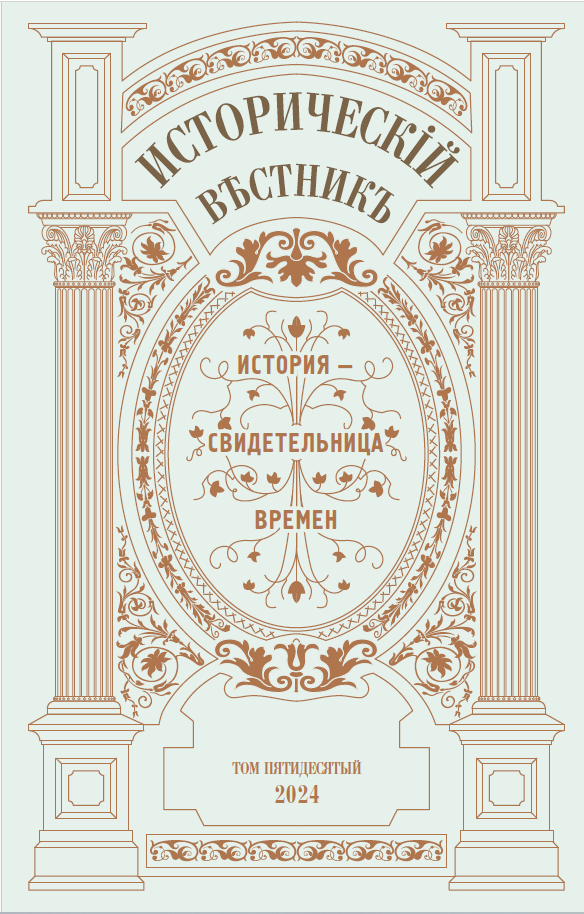
Гюль Шен Военно-морской арсенал Османской империи, преступность и пенитенциарная система около 1700 г.
DOI: 10.35549/HR.2024.2024.50.003Гюль Шен. Военно-морской арсенал Османской империи, преступность и пенитенциарная система около 1700 г. // Исторический вестник. 2024. Т. L. С. 92–111.
Аннотация
В начале Нового времени боевая сила флота Османской империи во многом опиралась на использование подневольного труда, в частности военнопленных и преступников. Поддержание военного господства на побережье и в акватории Восточного Средиземноморья требовало огромного количества гребцов, особенно во время весенней и летней навигации. Для получения, удержания и организации этой рабочей силы использовались все возможные средства. Данная статья исследует вопрос привлечения преступников в османский флот и изменение роли Военно-морского арсенала в 1700 году, опираясь на соответствующие реестры. Журналы учета осужденных Императорского военно-морского арсенала в Стамбуле свидетельствуют, что в некоторых случаях даже простая кража могла привести к каторге на галерах. Такие случаи, в частности, указывают на то, что органы правопорядка выступали удобным способом набора рабочей силы для флота. Еще один важный аспект заключается в том, что этой практикой Османское государство следовало тенденции, наметившейся в северо-западной Европе с XVII века: наказывать провинившихся за преступления и нарушения общественного порядка не физически, а направляя их труд на службу обществу.
Ключевые слова:Османская империя, Средиземноморье, флот, труд, военно-морской арсенал, осужденные, гребцы.
Гюль Шен– доктор философских наук (история Ближнего Востока), доцент. Боннский университет, Институт восточных и азиатских исследований.
ORCID: 0000-0002-0364-0682
***
GülŞen.Ottoman Naval Arsenal, Criminality, and Law Enforcement around 1700// Historical Reporter.2024.Vol.50P.92–111.
Abstract
Naval warfare in the Ottoman Empire was based largely on the use of unfree labor, such as war captives and criminals in the early modern period. The need for oarsmen to maintain the military dominance at the coast and sea of the Eastern Mediterranean was enormous, especially during the navigating season in spring and summer. To attract, maintain and organize this labor force, all available means were used. Drawing on the registers of the Naval Arsenal in Istambul, this article examines the issue of recruitment of criminals for the Ottoman Navy and the changing role of this institution around 1700. The convict registers of the Naval Arsenal document that in in some cases even a simple theft could result in a condemnation for hard labor on the galleys. Such cases suggested that law enforcement was seen here as a convenient means of recruit naval workforce. Another important aspect is that with this practice the Ottoman state followed the tendency in north-western Europe since the seventeenth century to punish crimes and violations of the public order no longer with the physical destruction of the delinquent, but to place their labor in the service of the public.
Keywords:Ottoman Empire, Naval Arsenal, Navy, Marinearsenal, Labor, Convicts, Oarsmen.
Gül Şen– PD. Dr. (Middle Eastern History), Privatdozentin, University of Bonn, Institute of Oriental and Asian Studies
ORCID: 0000-0002-0364-0682
***
References
- Archives the of Presidency of the Republic of Turkey — Ottoman Archive. Bāb-ı Defteri, Baş Muhasebe Kalemi, Tersane Zindanları [Reestr osuzhdennyh voenno-morskogo arsenala], № 15749 (1703–1706).
- Aykan Yavuz, Boğaç Ergene. Shari’a courts in the Ottoman Empire before the Tanzimat // The Medieval History Journal, 22/2 (2019): 203–228.
- Barkan Ömer Lütfi. Türkiye`de Din ve Devlet ilişkilerin Tarihsel Gelişimi// Türk Tarih Kurumu Yayınları 7/71 (1975): 49–97.
- Barkey Karen. Aspects of Legal Pluralism in the Ottoman Empire // Lauren Benton / Richard J. Ross (eds.). Legal Pluralism and Empires, 1500–1850. New York, 2013. P.83–107.
- Başaran Betül. Crime, Violence and Urban Policing // Shirine Hamadeh, Çiğdem Kafescioglu (eds.). A Companion to Early Modern Istanbul. Leiden: Brill, 2021. P.446–472.
- Başaran Betül. Selim III, Social Control and Policing in Istanbul at the End of the Eighteenth Century. Leiden: Brill, 2014. P.106–126.
- Bostan İdris. Osmanli Bahriye Teşkilâtı: XVII Yüzyılda Tersâne-i Âmire. Ankara: Türk Tarih Kurumu, 1991.
- Braudel Fernand. Sozialgeschichte des 15–18, Jahrunderts, vol. 2: Der Handel. München: Kindler, 1986.
- Darling Linda T. A History of Social Justice and Political Power in the Middle East: The Circle of Justice from Mesopotamia to Globalization. New York: Routledge, 2013.
- Faroqhi Suraiya. Migration into Eighteenth-Century «Greater Istanbul» as Reflected in the Kadi Registers of Eyüp // Turcica 30 (1998): 163–183.
- Guilmartin Jr., John Francis. Gunpowder and Galleys: Changing Technology and Mediterranean Warfare at Sea in the 16th Century. London: Cambridge University Press, 2003.
- Heberer von Bretten, Johann Michael. Aegyptiaca Servitus, intr. by Karl Teply, reprint. Graz: Akademische Druck- und Verlagsanstalt, 1967, репринт оригинала 1610г.
- Heyd Uriel. Studies in Old Ottoman Criminal Law. Oxford: At the Clarendon Press, 1973.
- İnalcık Halil. Osmanlı Hukukuna Giriş // Ankara Üniversitesi SBF Dergisi 13 (1958): 102–126.
- Isely Andrea. Gute Policey: Öffentliche Ordnung in der Frühen Neuzeit. Stuttgart: E. Ulmer, 2009.
- Katib Çelebi. Tuhfetü’l-Kibâr fî Esfâri’l-Bihâr (ed.). İdris Bostan. Ankara: Türkiye Bilimler Akademisi, 2018.
- Kılınç Ahmet. Klasik Dönem Osmanlı Devleti’nde uygulanan Kürek Cezasının Hukuki Tahlili // Belleten 79 (2015): 531–558.
- Martheile Jean. Gedenkschriften van eenen protestant, veroordeelt op de galeijen van Vrankryk, ter oorzake van den godsdienst. Daniel de Superville (de Jongh) (ed.). Rotterdam: Jan Daniel Bemann en zoon, 1757.
- Naʿīmā Muṣṭafā. Ravżat el-Ḥuseyn fi ḫulāṣat-i aḫbār el-ḫāfiḳayn. Tārīḫ-i Naʿīmā, vol. V. P.201–202. Istanbul 1864–1866, 4th edition.
- Şen Gül. Between Two Spaces: Enslavement and Labor in the Early Modern Ottoman Navy // Stephan Conermann, Youval Rotman, Ehud Toledano, Rachel Zelnick-Abramovitz (eds.). Comparative and Global Framing of Enslavement, Berlin: De Gruyter, 2023. P.133–166.
- Şen Gül. Galley Slaves and Agency: The Driving Force of the Ottoman Fleet // Stephan Conermann and Gül Şen (eds.). Slaves and Slave Agency in the Ottoman Empire. Göttingen: V&R unipress. P.131–163.
- Wratislaw Wenceslas. Adventures of Baron Wenceslas Wratislaw of Mitrowitz. Transl. Albert Henry Wratislaw. Cambridge: Cambridge University Press, 2013.
- Yılmaz Coşkun (ed.). İstanbul Kadı Sicilleri Bâb Mahkemesi 197 Numaralı Sicil (H. 1162–1163 / M. 1749–1750). İstanbul: İSAM, 2019.
- Zarinebaf Fariba. Crime and Punishment in Istanbul: 1700–1800. Berkeley: University of California Press, 2010.

